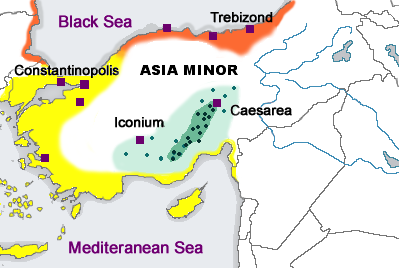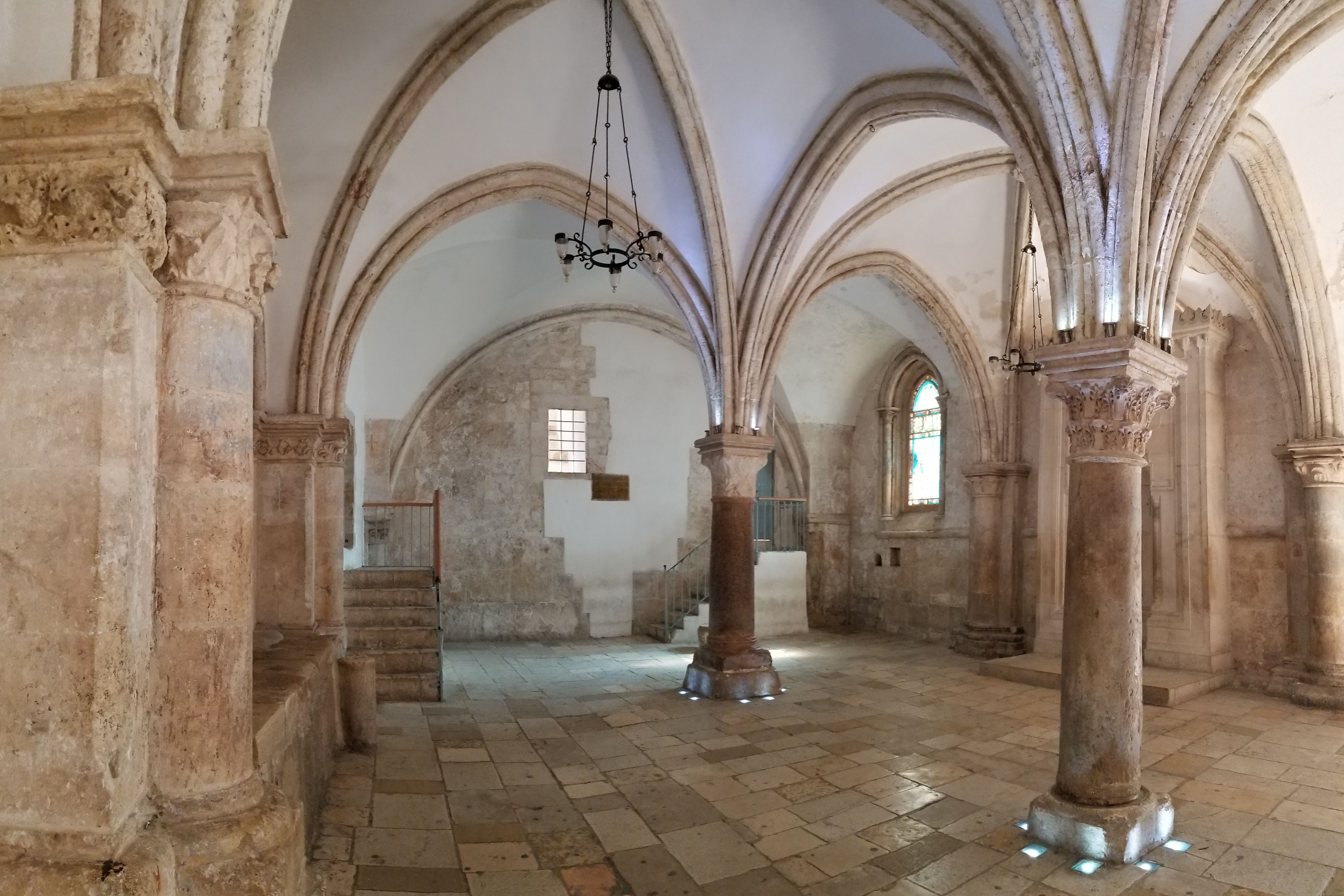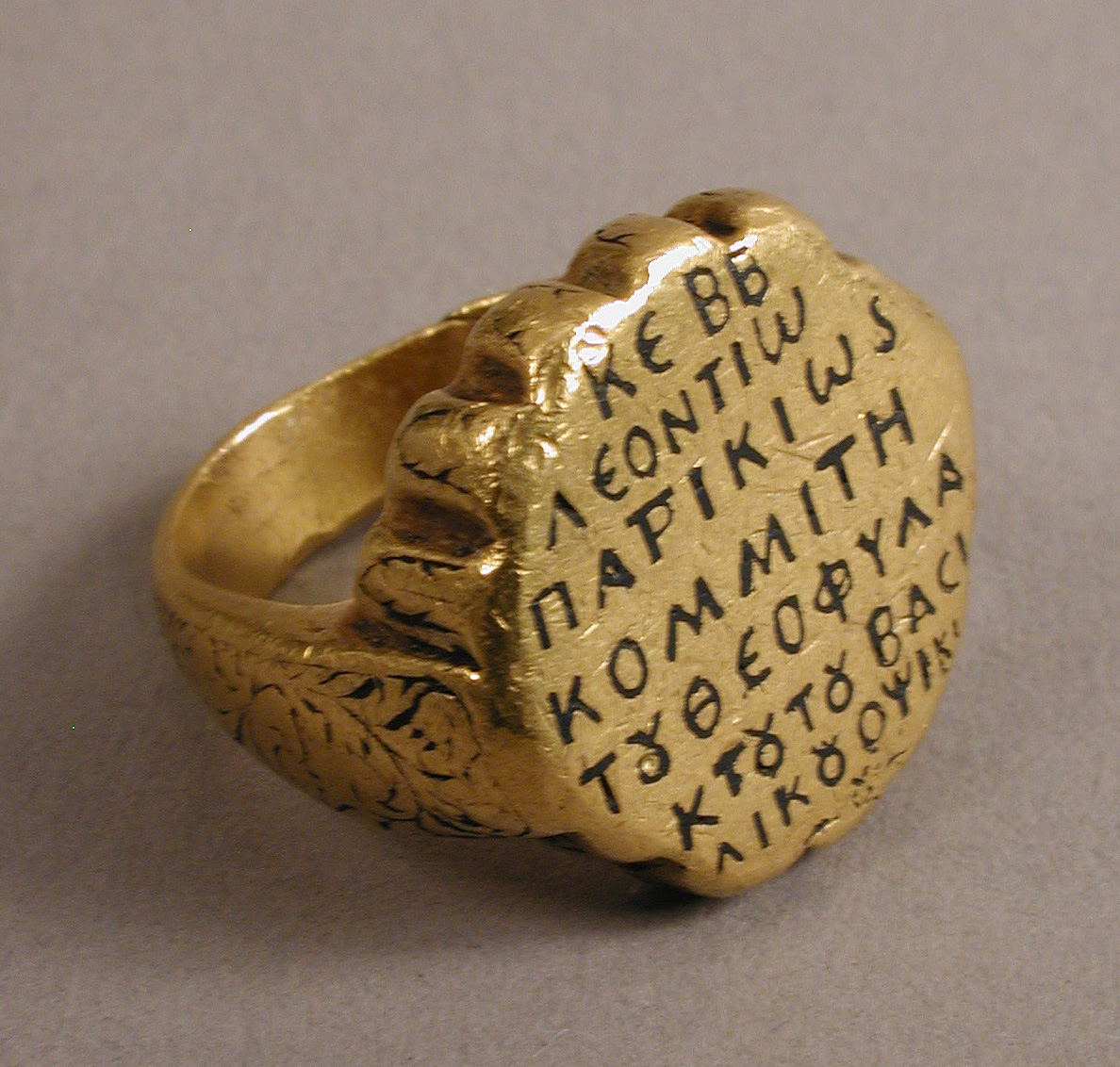|
Anna (wife Of Artabasdos)
Anna (Greek: Άννα, fl. 715–773 CE) was the wife of Artabasdos, one of two rival Byzantine emperors in a civil war which lasted from June, 741 to November, 743 CE. The other emperor was her brother, Constantine V. Family Anna was a daughter of Leo III the Isaurian and his wife Maria. She was a sister of Constantine V. She also had two sisters named Irene and Kosmo, whose names and place of burial were recorded in De Ceremoniis by Constantine VII, however nothing else is known of them. Marriage The throne of the Byzantine Empire was unstable in the early 710s. Justinian II had been deposed and executed in 711. His deposition was followed by the brief reigns of Philippikos (711–713), Anastasios II (713–715) and Theodosios III (715–717). All three were elevated to the throne after coup d'états by factions of the Byzantine army. Under these conditions two military commanders sought each other as allies. According to the chronicle of Theophanes the Confessor, Leo, stra ... [...More Info...] [...Related Items...] OR: [Wikipedia] [Google] [Baidu] [Amazon] |
Medieval Greek
Medieval Greek (also known as Middle Greek, Byzantine Greek, or Romaic; Greek: ) is the stage of the Greek language between the end of classical antiquity in the 5th–6th centuries and the end of the Middle Ages, conventionally dated to the Ottoman conquest of Constantinople in 1453. From the 7th century onwards, Greek was the only language of administration and government in the Byzantine Empire. This stage of language is thus described as Byzantine Greek. The study of the Medieval Greek language and literature is a branch of Byzantine studies, the study of the history and culture of the Byzantine Empire. The conquests of Alexander the Great, and the ensuing Hellenistic period, had caused Greek to spread throughout Anatolia and the Eastern Mediterranean. The beginning of Medieval Greek is occasionally dated back to as early as the 4th century, either to 330 AD, when the political centre of the Roman Empire was moved to Constantinople, or to 395 AD, the division o ... [...More Info...] [...Related Items...] OR: [Wikipedia] [Google] [Baidu] [Amazon] |
Strategos
''Strategos'' (), also known by its Linguistic Latinisation, Latinized form ''strategus'', is a Greek language, Greek term to mean 'military General officer, general'. In the Hellenistic world and in the Byzantine Empire, the term was also used to describe a military governor. In the modern Hellenic Army, it is the highest officer rank. Etymology ''Strategos'' is a compound of two Greek words: ''stratos'' and ''agos''. ''Stratos'' (στρατός) means 'army', literally 'that which is spread out', coming from the proto-Indo-European root *stere-, 'to spread'. ''Agos'' (ἀγός) means 'leader', from ''agein'' (ἄγειν), 'to lead', from the pelasgic root *ag-, 'to drive, draw out or forth, move'. Classical Greece Athens In its most famous attestation, in Classical Athens, the office of ''strategos'' existed already in the 6th century BC, but it was only with the reforms of Cleisthenes in 501 BC that it assumed its most recognizable form: Cleisthenes instituted a boa ... [...More Info...] [...Related Items...] OR: [Wikipedia] [Google] [Baidu] [Amazon] |
Hisham Ibn Abd Al-Malik
Hisham ibn Abd al-Malik ibn Marwan (; 6 February 743) was the tenth Umayyad caliph, ruling from 724 until his death in 743. Early life Hisham was born in Damascus, the administrative capital of the Umayyad Caliphate, in AH 72 (691–692 CE). His father was the Umayyad caliph Abd al-Malik ibn Marwan, Abd al-Malik (). His mother, A'isha, was a daughter of Hisham ibn Isma'il al-Makhzumi, Hisham ibn Isma'il of the Banu Makhzum, a prominent family of the Quraysh, and Abd al-Malik's longtime governor of the Islamic holy cities of Mecca and Medina. According to the history of al-Tabari (d. 923), Hisham was given the ''kunya (Arabic), kunya'' (patronymic) of Abu al-Walid. There is little information about Hisham's early life. He was too young to play any political or military role during his father's reign. He supposedly led the Hajj pilgrimage to Mecca once during his brother al-Walid I's reign () and while there, met a respected descendant of Caliph Ali (), Ali al-Sajjad, Zayn al-Abid ... [...More Info...] [...Related Items...] OR: [Wikipedia] [Google] [Baidu] [Amazon] |
Umayyad Caliphate
The Umayyad Caliphate or Umayyad Empire (, ; ) was the second caliphate established after the death of the Islamic prophet Muhammad and was ruled by the Umayyad dynasty. Uthman ibn Affan, the third of the Rashidun caliphs, was also a member of the clan. The family established dynastic, hereditary rule with Mu'awiya I, the long-time governor of Bilad al-Sham, Greater Syria, who became caliph after the end of the First Fitna in 661. After Mu'awiya's death in 680, conflicts over the succession resulted in the Second Fitna, and power eventually fell to Marwan I, from another branch of the clan. Syria remained the Umayyads' main power base thereafter, with Damascus as their capital. The Umayyads continued the Early Muslim conquests, Muslim conquests, conquering Ifriqiya, Transoxiana, Sind (caliphal province), Sind, the Maghreb and Hispania (al-Andalus). At its greatest extent (661–750), the Umayyad Caliphate covered , making it one of the largest empires in history in terms of ar ... [...More Info...] [...Related Items...] OR: [Wikipedia] [Google] [Baidu] [Amazon] |
Asia Minor
Anatolia (), also known as Asia Minor, is a peninsula in West Asia that makes up the majority of the land area of Turkey. It is the westernmost protrusion of Asia and is geographically bounded by the Mediterranean Sea to the south, the Aegean Sea to the west, the Turkish Straits to the northwest, and the Black Sea to the north. The eastern and southeastern limits have been expanded either to the entirety of Asiatic Turkey or to an imprecise line from the Black Sea to the Gulf of Alexandretta. Topographically, the Sea of Marmara connects the Black Sea with the Aegean Sea through the Bosporus and the Dardanelles, and separates Anatolia from Thrace in Southeast Europe. During the Neolithic, Anatolia was an early centre for the development of farming after it originated in the adjacent Fertile Crescent. Beginning around 9,000 years ago, there was a major migration of Anatolian Neolithic Farmers into Neolithic Europe, Europe, with their descendants coming to dominate the continent a ... [...More Info...] [...Related Items...] OR: [Wikipedia] [Google] [Baidu] [Amazon] |
Iconodule
Iconodulism (also iconoduly or iconodulia) designates the religious service to icons (kissing and honourable veneration, incense, and candlelight). The term comes from Neoclassical Greek εἰκονόδουλος (''eikonodoulos'') (from – ''icon (image)'' + – ''servant''), meaning "one who serves images (icons)". It is also referred to as iconophilism (also iconophily or iconophilia from – ''icon (image)'' + – ''love'') designating a positive attitude towards the religious use of icons. In the history of Christianity, iconodulism (or iconophilism) was manifested as a moderate position, between two extremes: iconoclasm (radical opposition to the use of icons) and iconolatry (idolatric veritable (full) adoration of icons). History In contrast to moderate or respectful adoration, various forms of latria of icons (''iconolatry'') were also starting to appear, mainly in popular worship. Since veritable (full) adoration was reserved for God alone, such an attitude t ... [...More Info...] [...Related Items...] OR: [Wikipedia] [Google] [Baidu] [Amazon] |
Iconoclasm (Byzantine)
The Byzantine Iconoclasm () are two periods in the history of the Byzantine Empire when the use of religious images or icons was opposed by religious and imperial authorities within the Ecumenical Patriarchate (at the time still comprising the Roman-Latin and the Eastern-Orthodox traditions) and the temporal imperial hierarchy. The First Iconoclasm, as it is sometimes called, occurred between about 726 and 787, while the Second Iconoclasm occurred between 814 and 842. According to the traditional view, Byzantine Iconoclasm was started by a ban on religious images promulgated by the Byzantine Emperor Leo III the Isaurian, and continued under his successors. It was accompanied by widespread destruction of religious images and persecution of supporters of the veneration of images. The Papacy remained firmly in support of the use of religious images throughout the period, and the whole episode widened the growing divergence between the Byzantine and Carolingian traditions in what wa ... [...More Info...] [...Related Items...] OR: [Wikipedia] [Google] [Baidu] [Amazon] |
Christianity
Christianity is an Abrahamic monotheistic religion, which states that Jesus in Christianity, Jesus is the Son of God (Christianity), Son of God and Resurrection of Jesus, rose from the dead after his Crucifixion of Jesus, crucifixion, whose coming as the Messiah#Christianity, messiah (Christ (title), Christ) was Old Testament messianic prophecies quoted in the New Testament, prophesied in the Old Testament and chronicled in the New Testament. It is the Major religious groups, world's largest and most widespread religion with over 2.3 billion followers, comprising around 28.8% of the world population. Its adherents, known as Christians, are estimated to make up a majority of the population in Christianity by country, 157 countries and territories. Christianity remains Christian culture, culturally diverse in its Western Christianity, Western and Eastern Christianity, Eastern branches, and doctrinally diverse concerning Justification (theology), justification and the natur ... [...More Info...] [...Related Items...] OR: [Wikipedia] [Google] [Baidu] [Amazon] |
Chalcedonian
Chalcedonian Christianity is the branches of Christianity that accept and uphold theological resolutions of the Council of Chalcedon, the fourth ecumenical council, held in AD 451. Chalcedonian Christianity accepts the Christological Definition of Chalcedon, a Christian doctrine concerning the union of two natures (divine and human) in one hypostasis of Jesus Christ, who is thus acknowledged as a single person ( prosopon). Chalcedonian Christianity also accepts the Chalcedonian confirmation of the Niceno-Constantinopolitan Creed, thus acknowledging the commitment of Chalcedonism to Nicene Christianity. Chalcedonian Christology is upheld by Catholicism, Eastern Orthodoxy, Lutheranism, Anglicanism and Calvinism (Reformed Christianity), thus comprising the overwhelming majority of Christianity. Chalcedonian Christology Those present at the Council of Chalcedon accepted Trinitarianism and the concept of hypostatic union, and rejected Arianism, Modalism, and Ebionism as ... [...More Info...] [...Related Items...] OR: [Wikipedia] [Google] [Baidu] [Amazon] |
Opsikion
The Opsician Theme (, ''thema Opsikiou'') or simply Opsikion (Greek: , from ) was a Byzantine theme (a military-civilian province) located in northwestern Asia Minor (modern Turkey). Created from the imperial retinue army, the ''Opsikion'' was the largest and most prestigious of the early themes, being located closest to Constantinople. Involved in several revolts in the 8th century, it was split in three after ca. 750, and lost its former pre-eminence. It survived as a middle-tier theme until after the Fourth Crusade. History The Opsician theme was one of the first four themes, and has its origin in the praesential armies of the East Roman army. The term ''Opsikion'' derives from the Latin term ''Obsequium'' ("retinue"), which by the early 7th century came to refer to the units escorting the emperor on campaign. It is possible that at an early stage, the ''Opsikion'' was garrisoned inside Constantinople itself. In the 640s, however, following the disastrous defeats suffered dur ... [...More Info...] [...Related Items...] OR: [Wikipedia] [Google] [Baidu] [Amazon] |
Count
Count (feminine: countess) is a historical title of nobility in certain European countries, varying in relative status, generally of middling rank in the hierarchy of nobility. Pine, L. G. ''Titles: How the King Became His Majesty''. New York: Barnes & Noble, 1992. p. 73. . Especially in earlier medieval periods the term often implied not only a certain status, but also that the ''count'' had specific responsibilities or offices. The etymologically related English term " county" denoted the territories associated with some countships, but not all. The title of ''count'' is typically not used in England or English-speaking countries, and the term ''earl'' is used instead. A female holder of the title is still referred to as a ''countess'', however. Origin of the term The word ''count'' came into English from the French ', itself from Latin '—in its accusative form ''comitem''. It meant "companion" or "attendant", and as a title it indicated that someone was delegated to ... [...More Info...] [...Related Items...] OR: [Wikipedia] [Google] [Baidu] [Amazon] |
Kouropalates
''Kouropalatēs'', Latinized as ''curopalates'' or ''curopalata'' (, from " he one incharge of the palace"). and anglicized as curopalate, was a Byzantine court title, one of the highest from the time of Emperor Justinian I to the Komnenian period in the 12th century.. The female variant, held by the spouses of the ''kouropalatai'', was ''kouropalatissa''. History and nature of the title The title is first attested (as ''curapalati'') in the early 5th century, as an official of '' vir spectabilis'' rank under the ''castrensis palatii'', charged with the maintenance of the imperial palace (cf. Western European " majordomo"). When Emperor Justinian I () made his nephew and heir Justin II ''curopalates'' in 552, however, the office took on new significance, and became one of the most exalted dignities, ranking next to '' Caesar'' and '' nobilissimus'' and, like them, reserved initially for members of the imperial family. Unlike them, however, it later came to be granted to impo ... [...More Info...] [...Related Items...] OR: [Wikipedia] [Google] [Baidu] [Amazon] |







